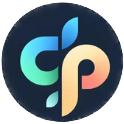Customized Coloring Sheets: Your Complete Creative Guide
June 19, 2025
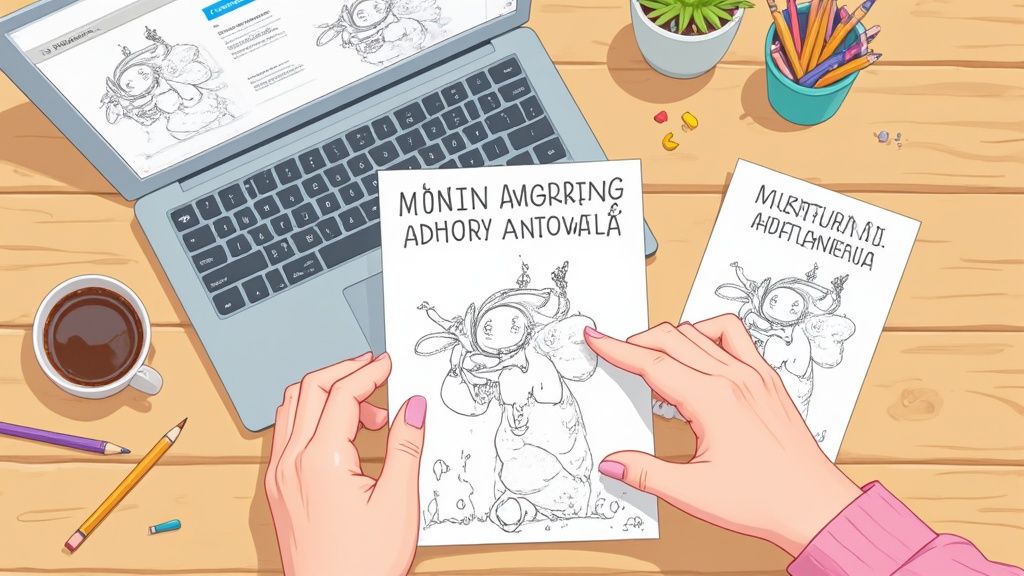
Why Everyone's Obsessed With Personalized Coloring
Something special is happening in the world of coloring. The generic, mass-produced coloring books we grew up with are being pushed aside for something far more engaging: personalized alternatives. The reason for this shift is simple—connection. We've grown tired of one-size-fits-all entertainment and now look for experiences that reflect our own lives, passions, and interests. This is exactly why customized coloring sheets are becoming so popular, changing everything from a quiet afternoon activity to a focused therapy session.
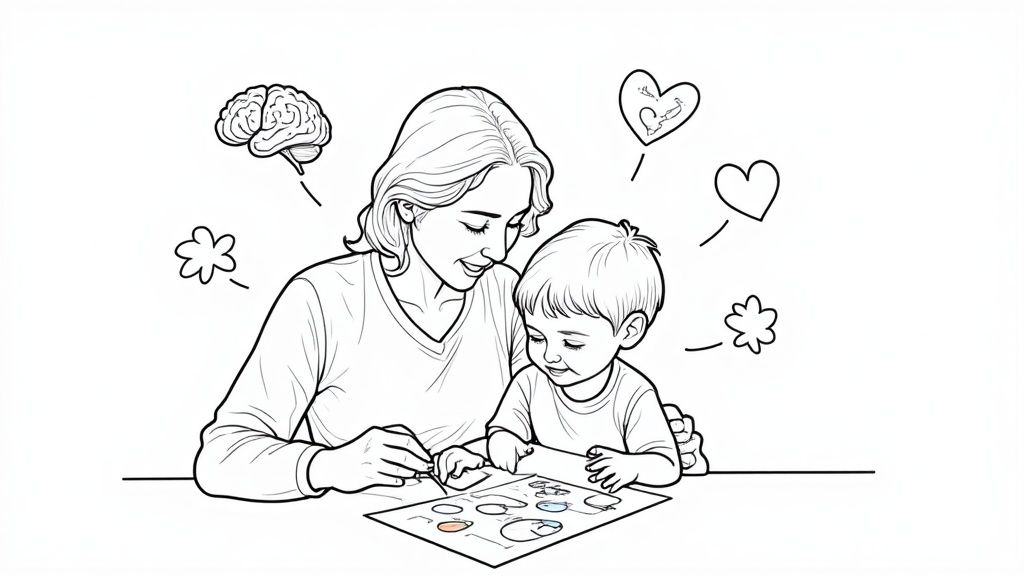
The Psychological Pull of Personalization
There's a certain magic in seeing a piece of yourself on a page waiting to be colored. When a child gets a sheet with their name next to their favorite superhero, the activity is no longer just about filling in lines—it becomes their personal adventure. This feeling of ownership is incredibly motivating. I've heard from teachers who saw classroom engagement skyrocket just by creating math problems presented by characters from a student's favorite video game. It's the same idea that makes a custom coloring page in a birthday party favor bag feel so much more thoughtful than a generic one.
This trend isn't just for kids, either. Adults are a huge part of this movement, looking for a break from screens and daily stress. The adult coloring book market was valued at around $151.23 million in 2024 and is projected to almost double by 2030, a clear sign that people are searching for mindful activities. Personalization makes this experience even better. While coloring a detailed mandala is calming, coloring a scene from your favorite vacation or a portrait of your pet creates a much deeper, more meaningful sense of peace. You can learn more about this incredible market growth from recent research on adult coloring trends.
More Than Just a Hobby: Therapeutic and Educational Impact
Beyond being a fun pastime, customized coloring sheets are proving to be powerful tools in more structured environments. Therapists are using them more and more to help clients of all ages express difficult emotions. For example, a child struggling to talk about anxiety might find it easier to color a picture of a brave lion—a character they picked—making its way through a dark forest. The creative process itself becomes a safe space for working through feelings.
In education, the uses are practically limitless and highly effective:
- Literacy: A coloring page that features the letters of a child’s name.
- History: Coloring sheets that show historical figures or events tied to a specific lesson.
- Science: Illustrations of specific animal habitats or the life cycles of plants that students are learning about.
The ability to create specific content helps make learning more memorable and fun, closing the gap between abstract ideas and hands-on, creative activities.
Setting Up Your Creative Arsenal
To create coloring sheets that people genuinely love, you need more than just a great idea—you need the right tools. The options can seem endless, ranging from free online generators to more advanced AI software. The trick is finding a balance between ease of use and the quality of the final product. I've found that many free tools often produce images with broken lines or low resolution, which are frustratingly unprintable. This is where a dedicated platform designed for coloring pages really shines, ensuring every design is crisp and ready for crayons.
As you get your workflow sorted out, it's also smart to think about your end goal. Are you making a few sheets for a family birthday party, or are you hoping to build a collection to sell? If you're planning to produce on a larger scale, you might want to look into how to create your personalized sheets efficiently. For instance, utilizing a print-on-demand service can handle all the printing and shipping, freeing you up to focus on the fun, creative side of your projects.
Mastering the Technical Essentials
Before you even think about writing your first prompt, getting a handle on a few technical details will save you a ton of headaches later. The most critical detail is resolution. For a standard 8.5x11 inch piece of paper, you'll want your image to be at least 300 DPI (dots per inch). This is the secret to getting those sharp, clean printed lines instead of a blurry, pixelated mess. Most professional AI tools, including our own, generate high-resolution files automatically.
When it comes to file formats, PDF is usually your best bet for sharing and printing because it preserves the layout and quality no matter what device it's viewed on. PNG files with transparent backgrounds are also fantastic if you plan to layer your designs or use them in other digital projects.
Choosing the Right Tool for the Job
The biggest decision you'll make is what software to use. Your choice between a dedicated AI tool and traditional design software like Adobe Illustrator or Canva really depends on your goals, budget, and how much time you want to spend learning.
To help you decide, here’s a quick comparison of the two main approaches:
| Tool Type | Cost | Learning Curve | Customization Level | Best For |
|---|---|---|---|---|
| AI Coloring Page Generators | Low (often subscription-based or pay-per-image) | Very Low (type a prompt and go!) | Moderate to High (prompt-based) | Quickly creating a large volume of unique, imaginative pages without design skills. |
| Traditional Design Software | Varies (free versions to expensive subscriptions) | High (requires learning design principles and software) | Very High (total control over every line and shape) | Designers who want complete artistic control and are creating very specific, polished illustrations. |
Ultimately, AI generators are perfect for speed and creative exploration, turning your text ideas into visuals in seconds. Traditional software gives you pixel-perfect control but requires a much bigger investment in time and skill.
The basic process for creating your sheets is pretty simple, as this infographic illustrates.
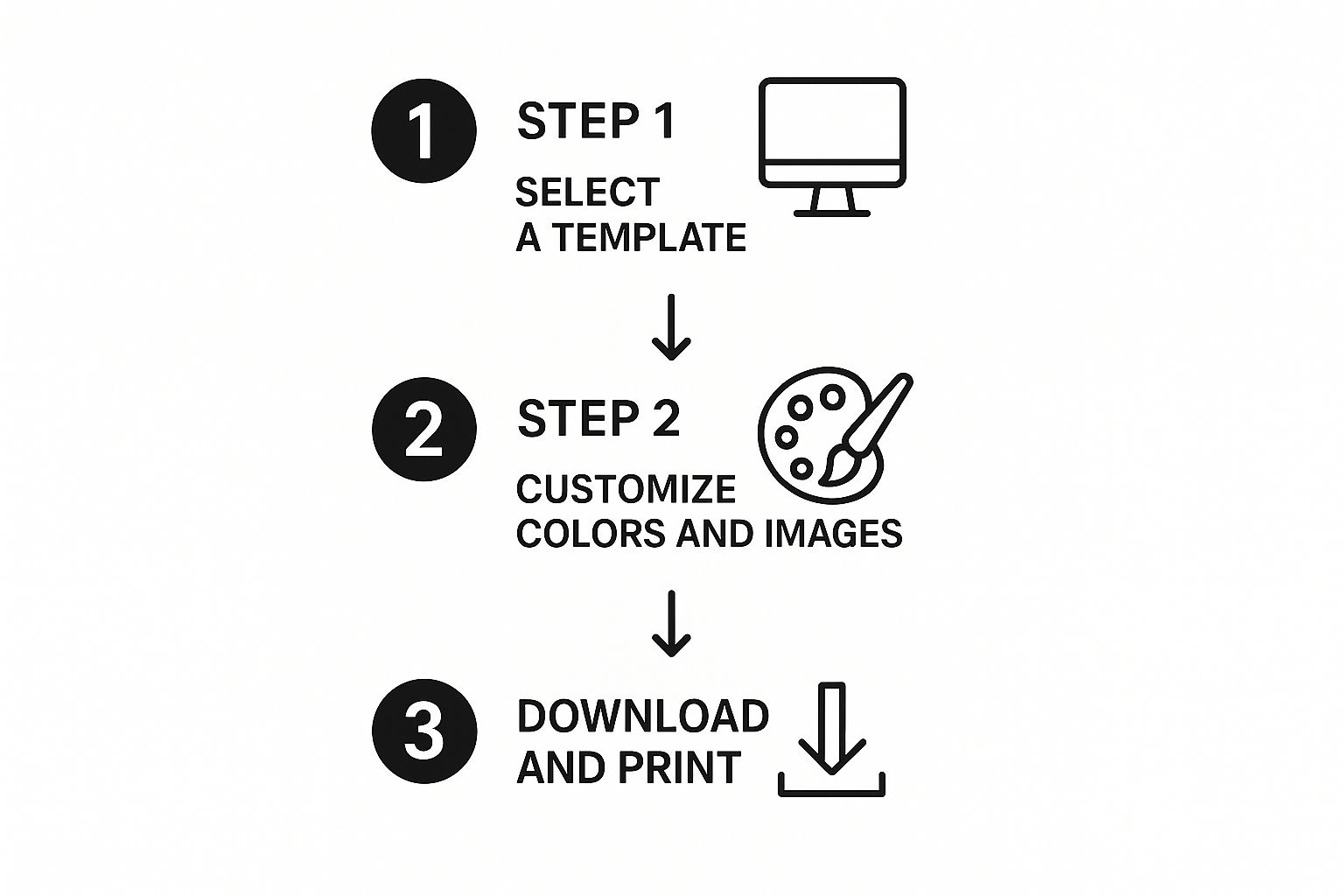
This visual guide breaks down the creation flow, showing that the real magic happens during the customization step—where your unique ideas truly take shape.
Key Design Principles for Great Sheets
Beyond the technical stuff, good design is what makes a coloring page genuinely enjoyable. Always think about who will be coloring it.
- For a toddler: Use thick, bold lines and simple, recognizable shapes.
- For an adult: Feel free to incorporate intricate patterns, mandalas, and finer details.
It's also important to think about cultural relevance. Creating designs that reflect diverse holidays, traditions, and figures can make your coloring sheets feel much more personal and inclusive. If you're looking for more ideas on what makes a design stand out, you might find our guide on creating truly unique custom coloring sheets helpful. These principles, combined with the right technical setup, create the foundation of your creative arsenal, preparing you to make some incredible, personalized art.
Bringing Your Vision To Life
This is where the magic really happens—turning your ideas into actual designs that people are excited to color. The goal here is to think beyond basic prompts and start creating with a clear purpose. Think about who will be coloring your pages and what kind of feeling you want them to have. Are you going for a calming, meditative experience for adults, or something bright and fun for kids? Every decision you make, from the theme to the level of detail, shapes the final product.
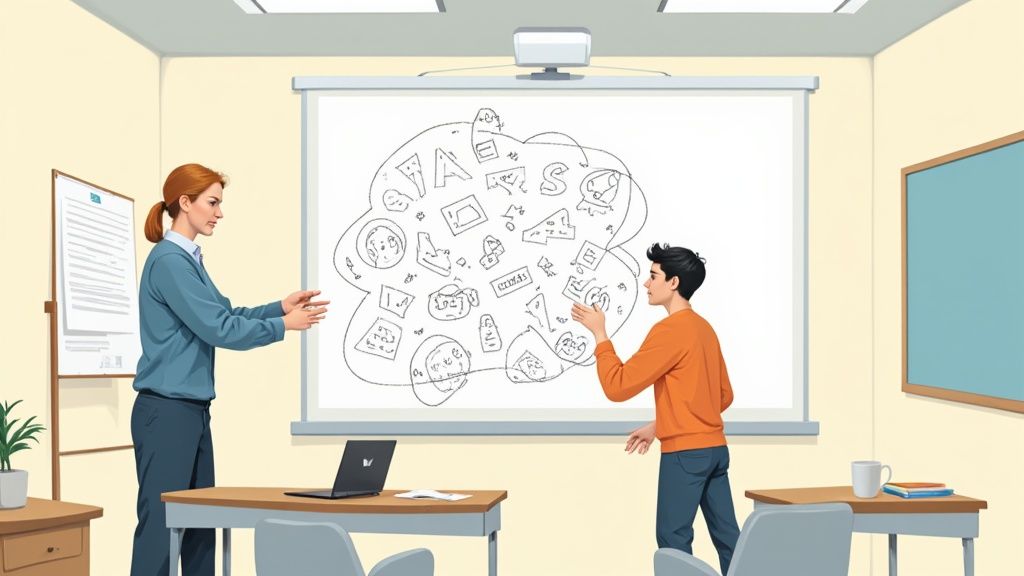
Developing Themes That Connect
A solid theme is the heart of any great coloring page. Let’s walk through a real-world scenario: you want to create a set of pages to help a child feel brave about their first day of school. Instead of a simple prompt like "school supplies," a much more engaging theme would be "a friendly tiger's first day at jungle school." This narrative approach gives you so many more creative options—the tiger packing his lunch, meeting his sloth teacher, or playing with monkey classmates at recess.
When you're ready to create these kinds of unique scenes, exploring tools for mass AI image generation like Midjourney can give you both inspiration and the power to produce amazing results. Thinking thematically is the key to making a set of pages that feels connected and memorable.
Another great angle is to create designs that help people relax. Nature themes are perfect for this. Instead of just prompting "flowers," you could try "a secret garden at twilight" or "a serene mountain landscape with a hidden waterfall." These specific themes not only tell the AI what to create but also tap into the well-known calming effects of nature scenes. Both teachers and parents are using personalized coloring content more and more to help with learning and therapy. You can discover more insights about the growing market for these activities on Verified Market Research.
Finding the Right Balance of Detail
One of the trickiest parts of making customized coloring sheets is getting the balance between detail and simplicity just right. A design that's too simple might bore an adult, but one that's too complex can be overwhelming for a child. A good rule of thumb is to vary the intricacy within the same picture.
Here are a few tips I've learned for finding that sweet spot:
- Create a Focal Point: Make the main subject—like a character or animal—fairly simple with thicker, cleaner lines. This makes it easy and inviting to start coloring.
- Add Optional Complexity: Use the background for more detailed, optional elements. Think intricate leaf patterns, subtle textures on a wall, or tiny flowers in a field. This lets the person coloring choose how much detail they want to tackle.
- Test Your Designs: Before you call a design finished, do a quick test run. Color a small section yourself. Even better, get feedback from someone in your target audience. Ask them directly: Was this fun? Were any parts too hard or too boring?
Focusing on the user's experience ensures your pages don't just look good, but are genuinely enjoyable to complete. This is what keeps people coming back for more of your unique designs.
Mastering Advanced Personalization Techniques
Once you've got the basics down, this is where the real fun begins. Moving beyond simple prompts is how you create truly customized coloring sheets that feel special and one-of-a-kind. We're not just talking about slapping a name on a generic design; we're talking about weaving personal details—like names, important dates, or meaningful symbols—right into the artwork itself.
Weaving Personal Details into Your Designs
Anyone can add a text box over an image, but the real magic is making those personal touches feel like a natural part of the drawing.
- For Names: Instead of just typing a name in a standard font, prompt the AI to get creative. For a kid named "Lily," you could ask for her name to be formed from twisting flower vines. For "Leo," imagine his name written in a bold font that looks like a roaring lion's mane.
- For Dates and Symbols: A coloring sheet for a wedding anniversary could have the special date subtly carved into a tree trunk within a romantic forest scene. For a graduation page, the year could be part of a stack of books or integrated into the architecture of a campus building.
This approach turns simple information into an artistic element, making the final coloring page much more meaningful. Once you have your AI-generated image, you can use a design tool to add these finishing touches.
For instance, you can upload your AI-generated coloring sheet into a platform like Canva and use their tools to layer text or additional graphics onto your design.
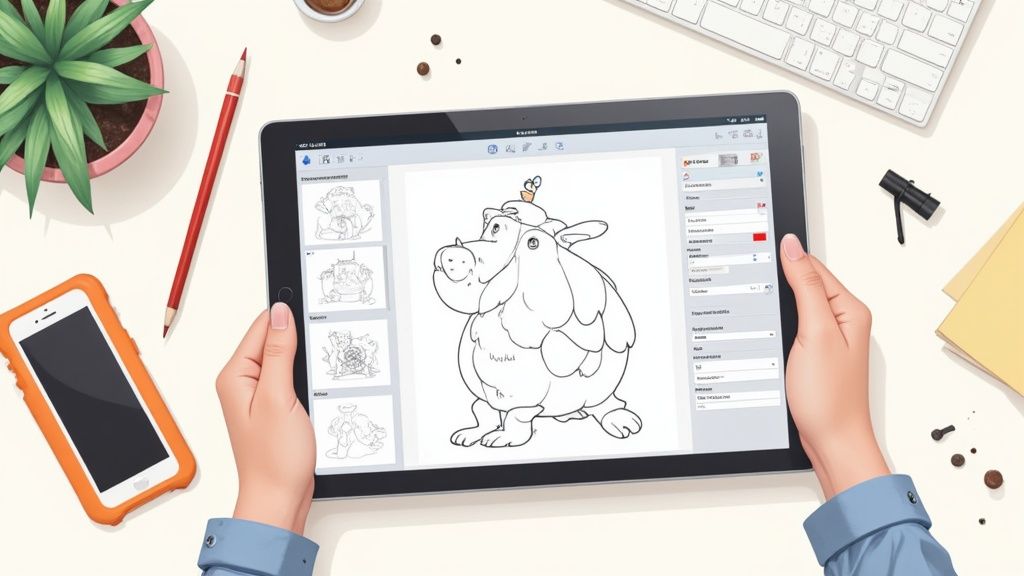
This screenshot gives you an idea of how you can easily place text boxes, graphics, and other elements to complete your design before you print it.
Creating Thematic Collections
Another great way to step up your game is to think bigger than a single page. Why not create an entire collection or a series? This builds excitement and keeps people coming back for more. Imagine a "Magical Pet Adventures" series where each sheet features the same personalized pet character but in a new, fantastic setting—one day they're exploring an underwater city, the next they're flying through clouds made of candy.
To pull this off, you need to keep the style consistent. Make sure your AI prompts include keywords for the artistic style (like "whimsical storybook illustration" or "bold comic book art") so that every page in the series feels like it belongs. This type of creative production has become much more accessible lately. The availability of digital tools and on-demand printing has fueled the entire market for customized coloring sheets, giving creators everywhere the power to produce unique art. You can even see the market trends shaping custom art activities on DataIntelo.
By building a cohesive series, you’re not just providing a single activity; you're creating a world for someone to explore.
Professional Printing and Distribution Secrets
Creating a beautiful design is only half the adventure; getting it to look just as good on paper is where many people get tripped up. The secret isn't a super-expensive printer, but rather understanding the relationship between your digital file, the ink, and the paper you choose. The goal is to produce customized coloring sheets that feel premium and are a joy to color, whether you're printing one for your child or a hundred for your small business.
Choosing the Right Paper
The paper you select has a massive impact on the final coloring experience. Standard office paper (around 75-90 GSM) is totally fine for quick, disposable fun, but it will almost certainly bleed through if you use heavy markers or watercolors.
For a result that feels more professional and substantial, you have a couple of great options:
- Cardstock (175-220 GSM): This is the sweet spot for most coloring projects. It's thick enough to stop bleed-through from markers and holds up beautifully to crayons and colored pencils. It just feels more special and gives your creations a high-quality vibe.
- Mixed Media Paper (200-300 GSM): If you expect people might use wet media like watercolor paints or ink washes, this is your best bet. It’s specifically made to handle moisture without warping or pilling.
Based on my own projects, I've found that using paper with a weight of at least 175 GSM dramatically improves how people feel about the final product. It's a small upgrade that makes your coloring sheets feel less like a simple handout and more like a real piece of art. To get into the nitty-gritty, you can check out our complete guide on how to print coloring pages for perfect results, which covers everything from printer settings to file types.
To help you decide, here’s a quick breakdown of paper types and the best settings to use for each.
Paper Types and Print Settings Guide
Recommended paper weights, printer settings, and costs for different coloring sheet applications
| Paper Type | Weight (GSM) | Best For | Print Settings | Approximate Cost |
|---|---|---|---|---|
| Standard Office Paper | 75-90 GSM | Quick prints, practice, crayons, colored pencils | Standard/Normal Quality, Plain Paper setting | ~$0.01 - $0.03 per sheet |
| Cardstock | 175-220 GSM | Markers, gel pens, high-quality feel, party favors | High Quality, Cardstock/Heavy Paper setting | ~$0.10 - $0.25 per sheet |
| Mixed Media Paper | 200-300 GSM | Watercolor, ink, markers, professional art | High Quality, Matte/Specialty Paper setting | ~$0.30 - $0.75 per sheet |
| Matte Photo Paper | 120-180 GSM | Vibrant, crisp lines, framing after coloring | Photo Quality, Matte Photo Paper setting | ~$0.20 - $0.50 per sheet |
Ultimately, choosing cardstock is a fantastic all-around upgrade that delivers a much better experience without a huge increase in cost. It’s the perfect middle ground for most coloring needs.
Digital Distribution Done Right
If you plan to share your creations online, you want to protect your work while making it easy for others to use. The most straightforward and effective method is to distribute your coloring sheets as a high-resolution PDF. This format locks in your design, ensuring the lines stay crisp and the layout doesn’t change, no matter what device or printer someone uses.
You can also bundle multiple pages into a single PDF to create a themed coloring book. This is perfect for selling on platforms like Etsy or offering as a downloadable freebie on your blog. For an extra touch of protection, consider adding a subtle watermark with your name or website to your designs before you save them as a PDF.
Turning Passion Into Profit And Impact
What begins as a fun creative outlet can easily grow into something much bigger—a side hustle, a small business, or even a valuable resource for your community. The best part about creating customized coloring sheets is the sheer number of ways you can share your work, regardless of your skill level or how much time you can commit. You don't need a huge setup to make a real difference.
Finding Your Monetization Model
The path you take really boils down to your personal goals. If you're looking to bring in some extra income from your creations, there are several solid approaches to consider:
- Direct Sales on Marketplaces: Platforms like Etsy are a fantastic place to start. You can offer individual digital downloads or create themed bundles. The trick here is getting noticed, so spend some time crafting great titles, detailed descriptions, and attractive mockups of your colored-in pages.
- Subscription Services: If you’re ready to create new content regularly, a subscription model can provide a reliable income stream. Using platforms like Patreon or Ko-fi, you can offer subscribers exclusive monthly sheets or grant them access to your entire back catalog.
- Custom Commissions: Offer your design skills for one-of-a-kind projects. Think personalized birthday party favors, unique activities for wedding guests, or custom educational materials for a specific classroom. This is a great way to build your portfolio and get direct feedback from clients.
A huge part of this journey is figuring out the value of your work. It's something many creators find tricky, but feeling confident in what you charge is essential. If you need some help, there are some excellent guides on how to price handmade items that can walk you through factoring in your time, creativity, and any platform fees.
Beyond Profit: Making a Difference
Of course, making money isn't the only reason to get started. Many creators discover immense joy in simply contributing to their communities.
- Educators: Teachers are putting together amazing libraries of coloring sheets perfectly matched to their lesson plans. This makes subjects like history and science more engaging and memorable for students with different learning styles.
- Therapists: In a therapeutic environment, a personalized coloring page can be a fantastic tool for connection. It gives clients a way to express themselves non-verbally, opening up new avenues for communication and healing.
Whether your goal is profit or purpose, getting started is more achievable than ever. For anyone thinking about creating a more formal business, our guide on how to start a coloring book business provides a deeper look into taking that exciting next step.
Your Action Plan For Creative Success
Now that you’re feeling inspired and have the technical details down, let's sketch out a plan for your creative journey. Turning your cool ideas into amazing customized coloring sheets is a really fun process. Having a clear plan just helps keep it that way, stopping it from getting too complicated. This roadmap is here to guide you, whether you're making pages for family fun, for a classroom, or even for a new business venture.
Checklists for Each Creation Stage
A little bit of organization can make a huge difference. When you break your project down into smaller, more manageable phases, you make sure you don't forget any important details. Think of it like a recipe for your designs.
Phase 1: Ideation & Planning (The "What If" Stage)
- Know Your Audience: First, who are these for? Is it your 5-year-old nephew who's obsessed with space, a friend who needs to de-stress, or a history class learning about ancient Egypt?
- Brainstorm Your Themes: Jot down at least three fun themes. Go wild! Think "dinosaur tea party," "zen garden mandalas," or "famous inventors as superheroes."
- Gather Inspiration: Put together a small mood board. What kind of artistic styles do you like? Find some examples of line art that really click with your vision.
Phase 2: Design & Refinement (The "Making It Real" Stage)
- Write Your Prompts: This is where you talk to the AI. Write specific, descriptive prompts for your generator. Don't forget to include keywords for style, subject, and mood.
- Generate and Pick Your Favorites: Create a few different versions for each idea. Go through them and pick the one with the cleanest lines and the best overall layout.
- Personalize and Polish: Time for the final touches. You can add names or special dates using a simple design tool. Make sure your file is at least 300 DPI—this is key for getting sharp, crisp printouts.
Troubleshooting Common Challenges
Even with a great plan, you might run into a few bumps. Here are some quick fixes for common problems I've seen.
| Common Problem | Quick Solution |
|---|---|
| Muddy or Overly Complex AI Images | Simplify your prompt. Try using negative prompts like --no shading or --no gray to get cleaner line art that’s perfect for coloring. |
| Inconsistent Style Across a Series | Keep a "master prompt" document. For every image in your collection, reuse the exact same style keywords, like "whimsical storybook style, thick outlines." |
| Printed Colors Look Faded | Check your printer settings. Always choose "High Quality" or "Best" mode. If you're using thicker paper like cardstock, be sure to tell the printer that too. |
By thinking about these little issues ahead of time, you can keep your creative flow going without any interruptions. This structured approach lets you focus on the most important part: bringing your unique vision for customized coloring sheets to life.
Ready to stop planning and start creating? Generate up to five unique, high-quality coloring pages for free with ColorPageAI and see your ideas appear in seconds. Start creating your first page now!
Ready to start coloring?
Join ColorPage.ai today and get 5 free credits to create your own custom coloring pages!
Start creating